- Getting around Lijiang. Dont stay in the Old Towns more than 2 days, there is nothing to do. KRISS Oct 9, 2013 05:46
- 2013 Beijing Temple Fair BENNYLAU Feb 26, 2013 03:29
- Malaysian traveling from KUL - LAX vis Shanghai PVG ZATI_DY Jan 3, 2013 20:15
Soaking up History: Zhongshan National Park
- Views: 6572
- |Vote: 0 0
- |Add to Favorites
- |Recommend to Friends
Nanjing & The Trouble With Historical Greatness
In a country so blessed, as China is, with a sumptuous historical background, it's perhaps easy to become complacent amid the claims of one city or another to historical "greatness". Particularly so when that historical greatness becomes packaged, as it is wont to do, in the bows and ribbons of the 21st century, barely visible beneath the gimmickry used to promote it. As such, I approached Nanjing with a healthy scepticism.
Nanjing, provincial capital of fertile Jiangsu, has seemed destined to be caught up in many of the hottest episodes of Chinese history and consequently its fortunes, and tragedies have been well documented. The city itself is replete with museums and historical sites, enough for weeks of considered exploration that made my two days feel hopelessly inadequate. From such a rich palate of possibilities, what should I choose to see?
I made by chance what turned out to be an inspired decision, to base my visit around Zhongshan Mountain National Park, including the Ming Dynasty Tomb of Zhu Yuanzhang, Dr Sun Yat Sen's Mausoleum and the Linggu Temple. These three areas were to provide a showcase of the amazing depths to Nanjing's history, coupled with unexpectedly sensitive preservation and located within the most beautiful, natural surroundings.
The Ming Dynasty Tomb
It's hard to disagree with the World Heritage's assessment that this tomb represents a masterpiece of "human creative genius" as I wander around the huge complex. The stunning gardens and leafy-treed pathways seem to soak up the crowds, and make for delightful walking in themselves. That amidst their verdant canopies lies the grandiose complex of a Ming Dynasty Tomb seems almost too good to be true.
Started in 1381, the tomb was to take 32 years to achieve completion and despite the fact that Emperor Zhu Yuanzhang was buried there in 1398, it wasn't officially finished until the erection of a final stele some 15 years later in 1413. Zhu Yuanzhang was the first emperor of the Chinese Ming Dynasty and the construction methods for the tomb complex, including the art of geomancy (fengshui), were to become the model for all future Ming and Qing Dynasty Tombs.
The "Sacred Way", as the approach to the tomb is called, begins with Stone Elephant Road, over 600m in length and flanked at intervals by pairs of stone animals including horses, camels, elephants and lions. Vast and formidable, the stone creatures provide a worthy guard against evil spirits as well as alluding to the greatness of the emperor in their proud glances and imposing stature.
Each animal guarding the tomb has been specifically chosen for its merits and associations. The "unicorn" of Chinese legend, said only to appear during the reign of a wise and benevolent emperor; the camel (never before used) represents the emperor's reach of strength and peace in China's western regions; the lion, "King of the Beasts" and a holy creature in Buddhism, marks the emperor as powerful and dignified.
The Sacred Way continues along the Wenzhong Path, where huge stone generals and officials, well armed and kingly in bearing, watch over the pathway to the tomb reflecting their most valued characteristic: loyalty.
Across Golden Water Bridge, originally a set of 5 parallel single-arched bridges of which only 3 now remain, I head up to the corresponding 5 archways in the Military Gate that marks the entrance to the tomb itself. Beyond the gate are a series of further gates and halls, many of which have suffered damage through the centuries, and have been renovated at one time or another.
The tomb's architecture is recognisably "Ming", the halls dressed regally amidst the towering limbs and deep green foliage of ancient trees in their dusty-red walls and glazed orange tiled roofs. Beyond them wide stone pathways lead to stairways adorned with elaborately carved stone balustrades, from which the heads of beasts protrude.
Finally, through the tunnel that leads under the Rectangular Citadel, I reach the grave itself, or rather the Treasure Mound. The mound is 400m in diameter, enclosed within an almost invisible-walled compound through which, today, a peaceful woodland walk makes its way in a large circle. I try not to forget for one moment, despite the sunshine flickering through the trees, that somewhere beneath my feet the emperor, his wife and concubines lie in eternal sleep.
Dr Sun Yat Sen's Mausoleum and Museum
In 2005, recently arrived in China, I remember watching a live broadcast as a group of dignitaries mounted a tree-flanked stepped causeway up to a mausoleum, where 4 Chinese characters were written on a sheet of white paper and a great ceremony attended. Of course, it was all in Chinese and I had no idea of its significance.
It is only as I reach the final room in an exhibition dedicated to the life of Dr Sun Yat Sen that I receive a jolt of recognition, there is the paper, and even a video showing the TV coverage. The Memorial Hall exhibition calls him the "Man of the Century" and tells the compelling story of his life, ambition, achievements - and death - through images, captions and artefacts.
I find his life story quite moving, a study of a lifelong struggle to win freedom and democracy for his beloved Chinese nation, but nevertheless, at his death left China as a still volatile republic. At the height of his achievements is his overthrowing of the Qing Dynasty, but beyond this he worked tirelessly to help the peasants and migrant workers, forged ties between the Kuomintang and the Communist Party and maintained his belief in what was termed the "Democratic Revolution". His death, of liver cancer, (a copy of the autopsy written in English captures my eye in the exhibition), leads me to the great stepped causeway where his body now lies in a white marble coffin.
His mausoleum, I wonder if he would have approved, is striking and I can't fail to be moved not least by the enormous gateways carved from creamy Fujian marble and roofed with pale blue tiles that seem to shine out from the backdrop of mountain greenery. The blue and white colours represent the flag of the Kuomintang: a white sun on a blue background. The stairway of almost 400 steps stretches upwards for 323 metres and is 70 metres wide. It is designed in such a way that from the bottom, looking upwards, I can see nothing but steps, but once at the mausoleum, looking downwards, the steps are invisible and I can only see the flat terraces between the flights.
Construction of the Mausoleum didn't begin until a year after Dr Sun Yat Sen's death, and it wasn't until 1929 that his body was placed here. The tiny memorial chamber is circular, and I am part of a constant stream of visitors who look and take photographs (even though it says outside we shouldn't). I only take one, and I feel guilty about it. The roof overhead displays a mosaic of the Kuomintang flag and the "Father" of modern China seems very small beneath it.
Linggu Temple
Linggu Temple is the lesser known of the three "main" sites, but still makes for a pleasant hour, and more, of exploration. The chief attraction is the temple that stands under the luxuriant shade of trees, cloaked in the scents of incense and possessed of the quiet intensity of all temples in China. It's not to be wondered at, the temple has been here for over 1500 years.
Of particular note is the hall dedicated to Xuanzang, a famous monk who lived in the Tang Dynasty and walked to India to return to China with the Buddhist sutras. Ironically, Xuanzang is probably better known as the real life inspiration for the fictional monk in one of China's four great literary classics, Journey to the West.
Aside from the temple, another structure worth seeing is the Beamless Hall, whose name serves two functions, equally interesting. The hall itself was constructed without the use of a single piece, or beam of wood, being entirely of stone and feeling like a vault. Also, it was originally intended to pay homage to the Amitabha Buddhist, whose name means "boundless life" and is echoed by the structures lack of formal boundaries. In 1931 the Kuomintang turned the hall into a memorial to all those who died during the 1926-28 revolution, their names are carved onto stone tablets throughout the hall.
Dominating the site however is the Linggu Pagoda, which is unrelated to the temple and stands as a memorial tower for Dr Sun Yat Sen. It was completed in 1935 and comprises 9 stories, standing over 60 metres in height. The tower has no particular attachment in history, but still commands a wonderful birds-eye view of the park from the top, which can be reached by a dizzying stone staircase that spirals its way up the centre.
The Open Air Music Hall
Situated to the south of Dr Sun Yat Sen's memorial, and accessible through a woodland glade, is another more recent addition to the sites here at Zhongshan, the Open Air Music Hall. It was built by Chinese architects Guan Songsheng and Yang Tingbao in 1933 and funded by donations from overseas Chinese in San Francisco as well as by the Liaoning branch of the Kuomintang.
The structure is designed much like a large fan, spreading in a semi-circle around a central stage. The stage is bordered at the front by a pool from which fountains dance to a host of classical Chinese tunes and at the back by a huge echo wall that collects and amplifies the sounds. The back edge of the semi-circle is a covered walkway, dripping with wisterias. The music hall has manicured grass for seats and stone pathways instead of aisles, the sky for a roof and trees for its scenery... and plenty of white pigeons masquerading as doves.
Nanjing: Historical Greatness
I began this article very much as I began my visit to Nanjing, uncertain, sceptical and full of curiosity. Could this modern city, so allied to its nation's history, be capable of preserving its own historical dignity? From my visit, my answer is a resounding positive. Yes it can! Yes it has!
Whilst I'm aware I've only scratched the surface of this city, and seen a small portion of its historical offerings, I am left with a sense of great optimism and delight about the prospect of returning to discover more.
Nanjing's Zhongshan National Park has undoubtedly managed to preserve the grandeur and dignity of all its historical sites, making it a pleasure for the traveller to explore. The gorgeous scenery and predominantly "behind-the-scenes" management and preservation has left the historical sites to speak for themselves, which is, after all, what they do best.
Travel Information (May 2008)
Getting There:
From: Hangzhou North Bus Station
Cost: 114.5RMB
Time: 4 hours (approx)
Regular buses leave throughout the day.
Entrance Fee:
A joint ticket can be bought which includes: the Ming Tomb, Dr Sun Yat Sen's Mausoleum & Memorial Hall/Exhibition, Linggu Temple Site and the Music Hall.
150RMB per person
The ticket is technically only valid for 1 day, however, as I bought my ticket late on the first day and wasn't able to see all the sites, I was allowed to use it on the second day after I explained the situation.
Single entry fee to each site otherwise is 80RMB per person.
Transport to Sites:
Public buses Y1, Y2 and Y3 are the best to use, they visit all the main tourist sites in Nanjing city though, and can take a while to get around, but tickets are very cheap and buses plentiful.
2RMB to anywhere
Be aware that the last buses finish quite early, around 5.30pm, after this you'll have to flag down a taxi or join some other people and get in a minivan!
Free transport via little road "trains" also take visitors between these sites at Zhongshan Mountain Park.



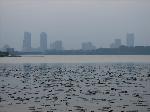


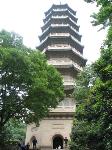
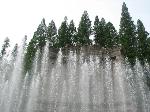
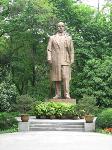
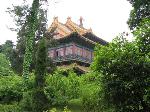
 Copyright © 1998-2024 All rights reserved.
Copyright © 1998-2024 All rights reserved.